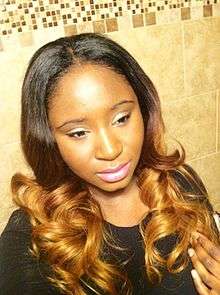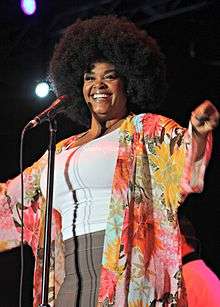Good hair

"Good hair" is a prejudiced phrase used within varying Black communities to generally describe the perceived prestige of loosely textured hair in contrast to its opposite which is tightly-coiled, indigenously Sub-Saharan African hair (or the hair texture belonging to those of other ethnicities who are of this descent). "Good hair" is not considered tightly coiled hair, but it is used contextually to describe socially acceptable hair textures that are visibly loosely curled, wavy and/or straight. It is often used in a patronizing manner to suggest that one's hair is "better" than Afro-textured hair.
Its usage has such a potent history within the African-American community that Chris Rock created a documentary entitled Good Hair, which made a wider audience more aware of the importance of the term within the Black community. Its circulation within the Black community in North America has an unspecified origin, predating Rock's documentary. Depending on the context, "good hair" can connote and evoke both communal laughter and pain. Therefore, the phrase requires a more nuanced explanation for its complicated usages.
Usage and scholarship
Although many hair stylists or beauticians would define "good hair" to mean "healthy hair", the phrase is rarely used in this manner within informal African-American circles. Instead it is used metaphorically to characterize beauty and acceptance. These standards vary for African-American men and women.
Historical view of "natural hair"
.jpg)
In her 2009 article, "Hairitage: Women Writing Race in Children’s Literature", the literary critic Dianne Johnson notes an early 1900s advertisement:
Once upon a time there lived a Good Fairy whose daily thoughts were of pretty little boys and girls and of beautiful women and handsome men and of how she might make beautiful those unfortunate ones whom nature had not given long, wavy hair and a smooth, lovely complexion.
— Johnson, 338
This ad was for hair products for black women developed by the highly successful African-American entrepreneur Madam C. J. Walker. Her advertisement played on the idea that curly hair was something to "be fixed". Johnson contends that more than 100 years later, many African-American women still overvalue straight hair.
Johnson notes that the characteristic (fill in blank), coarse hair of many ethnic Africans had historically been referred to in the United States during historic times as "nappy". As the term originated during the years when African Americans were held as slaves, especially in the South, it retains a negative connotation. Whites associated the natural, coarse hair of Africans with their second-class status as slaves and non-citizens.
Johnson explores whether white people understand the concept of "good hair" and its layers of meaning. She notes a controversy that arose in 1998 Brooklyn, New York when a young white schoolteacher, Ruth Sherman, shared the recently published children's book, Nappy Hair, with her predominately black elementary school students. (The book had received excellent reviews and won three awards, from Parenting Magazine, the Marion Vannett Ridgway 1998 Honor Book Award, and the Paterson Prize 1998 Books for Young People from the Poetry Center.)[1]
Although the book was written by Carolivia Herron, an African-American woman, and based on black traditions, some members of the black community objected to its use in the school by a white teacher. Some objected to the book's cover, which featured a young black girl with a big Afro. While some residents demanded that Sherman be removed from the school, most parents supported Sherman and her use of the book (Johnson, 343).[2]
The Washington Post reported that Herron said black students were her target audience for the children's book:
"I wrote it delighting in nappy hair," said Herron, who is black. "I love my own nappy hair and the stories my uncle used to tell me about it. It was a celebration, and I had no idea it would be political. I am a '60s person and thought we had already dealt with this problem of being ashamed of our hair."[2]
At her request, due to the uproar and threats, Sherman transferred to a different district.
Discrimination related to hair styles
During the first half of the 20th century in the United States, a period with more emphasis on dress codes than that of the 21st century, both white and black women in certain industries or businesses were restricted in their choice of hair styles. As an example of that period, black women working as stewardesses on American Airlines were prohibited from wearing an African-based style of braids. In Rogers v. American Airlines, the court ruled in favor of American Airlines and allowed them to ban women wearing their hair in a braided fashion.[3][4] Since the late 20th century, many restrictions have been loosened and African-American women wear a variety of hair styles in numerous professions, compared to late 1900s. However discrimination still prevails into the 2000s, with businesses and at one point even the American military, prohibiting styles such as natural or dreadlocks.
Other usages

Other prominent images
There are other images that perpetuate the binary of European hair types as being "good" and African hair types as being understood as inherently "bad", more widely understood as nappy or kinky hair. In the 19th century, black face minstrel shows became a popular form of entertainment. During this time, white actors would paint their faces black and lips red, fluff up or spike their hair, and make other noticeable changes to their physical bodies to create a caricature of the appearance of actual African-Americans, then use their altered appearance to make generalizations about African-Americans' perceived behavior, demeanor and intelligence.
Usage and resistance in African-American music
India.Arie, Jill Scott, Kehinde Spencer, and other artists have resisted adopting many of the images used to represent them and the content of their lyrics. Arie's "I Am Not My Hair", from her third studio released album Testimony: Vol. 1, Life & Relationship, however, speaks specifically to the usage of "good hair" as it is understood within the African-American community and in broader contexts.[5]
See also
References
- ↑ "Nappy Hair: Carolivia Herron official website".
- 1 2 Liz Leyden, "N.Y. Teacher Runs Into a Racial Divide", The Washington Post, 3 December 1998
- ↑ Crawford, 10
- ↑ Henson, Renee. "Library Guides: Title VII's Application of Grooming Policies and its Effect on Black Women's Hair in the Workplace: Rogers v. Am. Airlines, Inc., 527 F. Supp. 229 (S.D.N.Y. 1981)". libraryguides.missouri.edu. Retrieved 2018-01-16.
- ↑ India.Arie (songwriter) (2006). "I Am Not My Hair". Archived from the original on 9 November 2012. Retrieved 27 June 2011.
Other sources
- Battle-Waters, Kimberly (2004). Sheila's Shop: Working-Class African American Women Talk about Life, Love, Race, and Hair. Lanham, MD: Rowman & Littlefield.
- Page, Philip (1996). Dangerous Freedom: Fusion and Fragmentation in Toni Morrison's Novels. Jackson, MS: UP of Mississippi.
- Spencer, Kehinde (songwriter) (2009). "A Woman's Reprieve".
External links
- Muse, Michael (21 October 2009). "Fracturing Our Hair Part 1: Dear God, Please Give Me Good Hair. Amen". The Panther. Archived from the original on July 16, 2011. Retrieved 27 June 2011.
- Smedley, Audrey (2007). Race in North America: Origin and Evolution of a Worldview (3rd ed.). Boulder, CO: Westview Press. ISBN 9780813343570. Retrieved 27 June 2011.